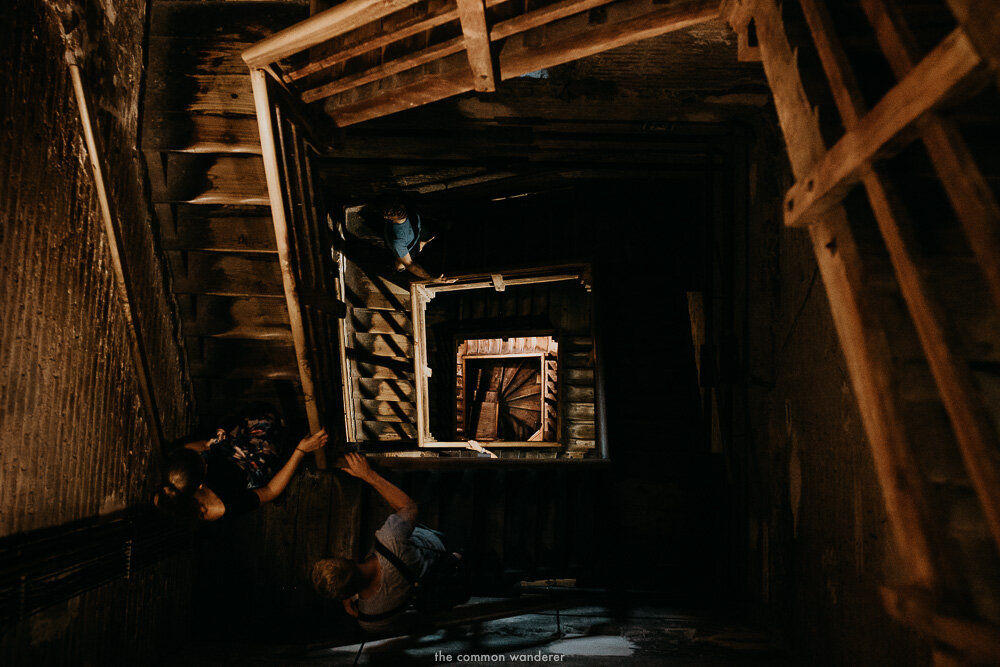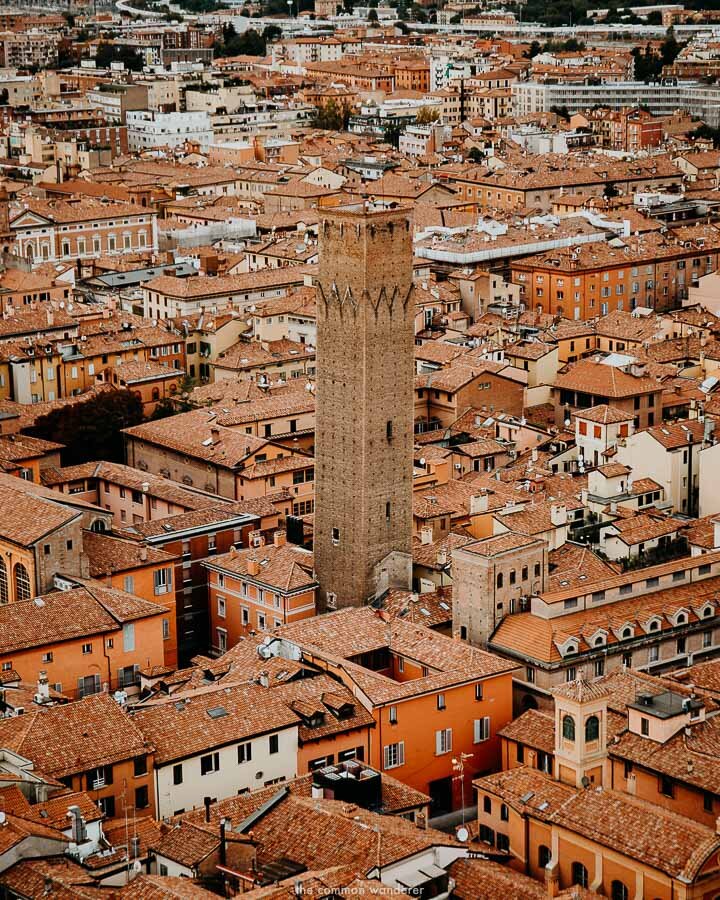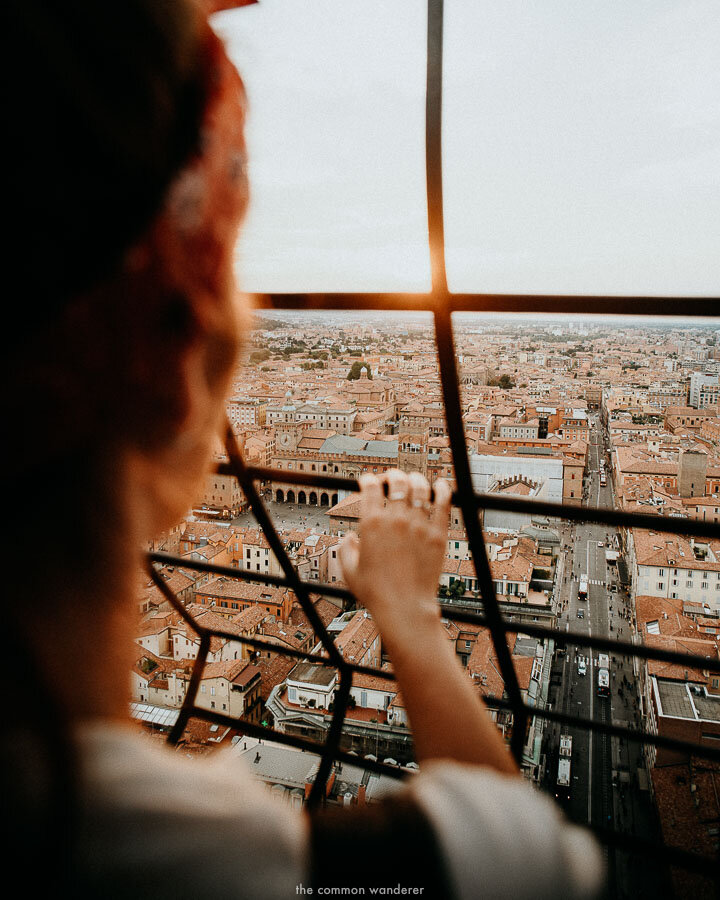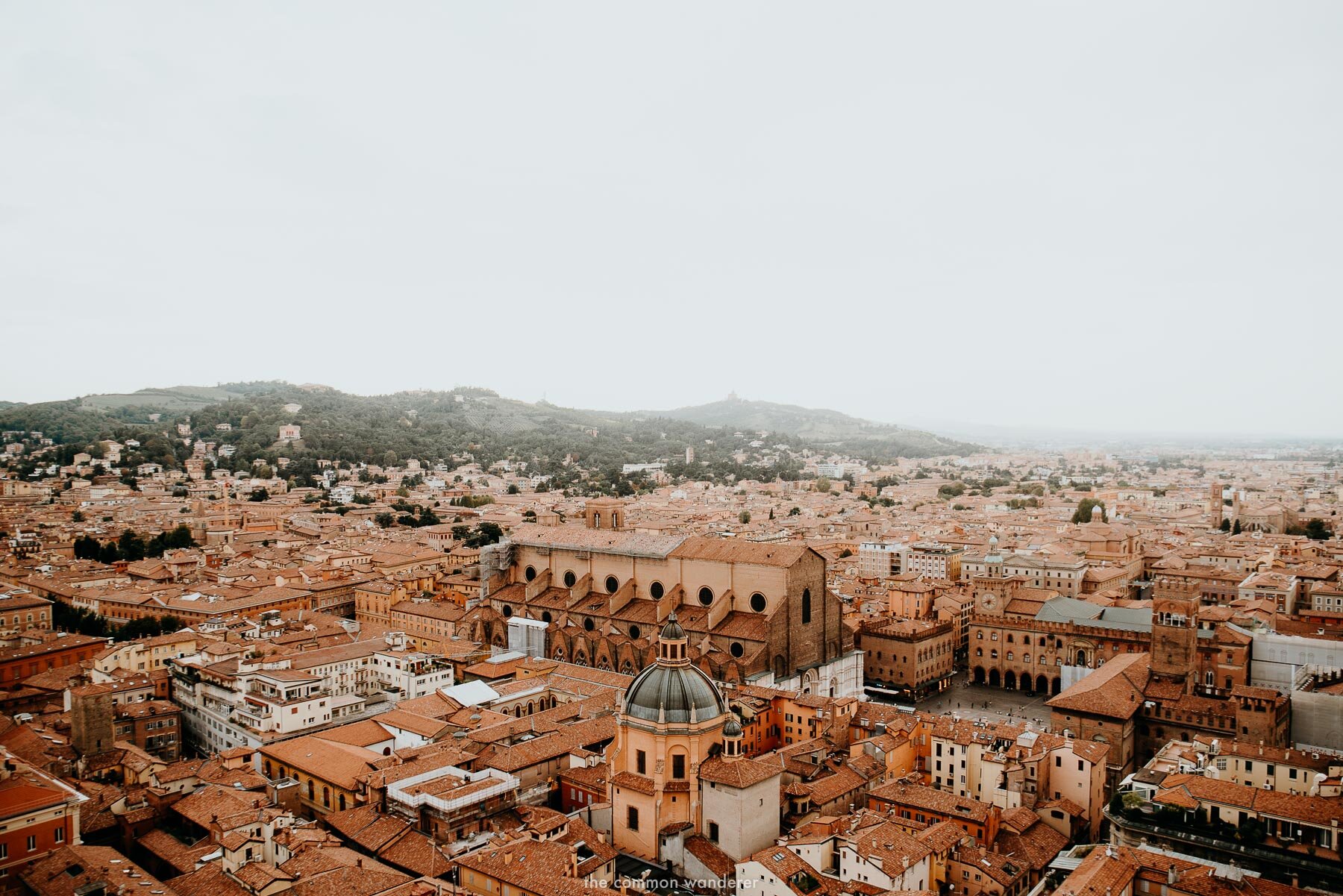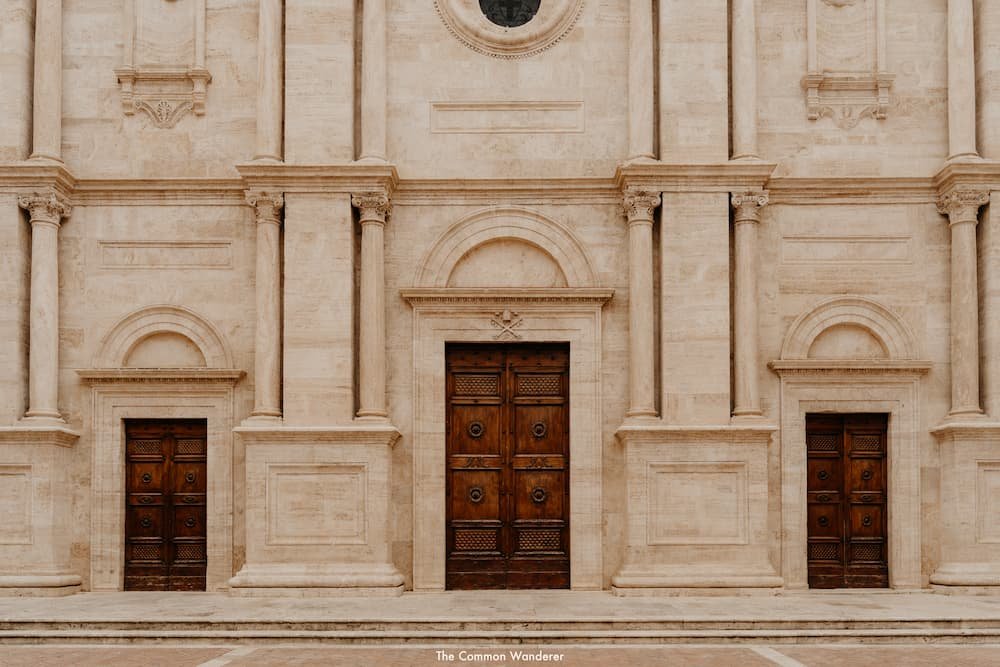A Short Guide to Le Due Torri, Bologna's Iconic Twin Towers
Bologna’s twin towers of Garisenda and Asinelli are the city’s icons, and a must-visit for any tourist exploring the ‘red city’. This short Le Due Torri guide covers all the essential information you need for your visit.
2024 UPDATE | Due to safety measures, the Asinelli Tower is currently CLOSED due to maintenance work in the area. As an alternative, visit the Clock Tower for views over Piazza Maggiore.
If climbing 498 narrow, wooden steps to the top of a 97.2m tall leaning medieval tower (leaning a noticeable 1.3° off-centre) for a birdseye view of Bologna sounds daunting, let us tell you - it is!
But trust us, the views from the summit of Asinelli Tower are unequivocally worth it, and watching the sunset high above the red city of Bologna was one of our favourite things to do in Bologna.
The twin towers of Bologna, or le Due Torri, are the number one attraction in Bologna and one of the most commonly recognised symbols of the city. Commenced in the 11th century, the pre-Renaissance towers were constructed by the Asinelli and Garisenda families as defensive fortifications, strategically placed at the entry point in the city of the ancient Via Emilia (Aemilian Way) to warn of any potential invaders.
The panoramic views over the red city are incredible - you can see Bologna in every direction. To the west is the marvellous Piazza Maggiore, and Basilica of San Luca, to the southwest, the ancient Roman road of via Emilia, and to the south the green rolling hills of the Emilia Romagna region. And if you're feeling brave, lean your head over the railing to look down upon the alleyways, courtyards and streets of Bologna.
Our short guide to the Le Due Torri, Bologna’s twin towers, runs through everything you need to know before visiting, including a brief history, an overview of our experience, the cost and opening hours of Le Due Torri, and other essential information for Bologna’s premier attraction.
CLIMBING BOLOGNA’S ICONIC TORRE DEGLI ASINELLI
A BRIEF HISTORY OF BOLOGNA’S TOWERS
Did you know that Bologna’s historic skyline resembled a middle-age Manhattan? Nope, neither did we! So what was the reason Bologna’s tower obsession?
Although the consensus amongst historians isn’t clear, it’s widely agreed that the city’s richest families used them for offensive and defensive purposes during the prior of the Investiture Controversy, the fight between the church and state during medieval times.
Built between the 11th and 13th centuries, there were up to 100 - 180 towers at points in history, and the towers of Bologna were even mentioned in Dante’s Inferno;
As when one sees the tower called Garisenda
from underneath its leaning side, and then a cloud
passes over and it seems to lean the more,
thus did Antaeus seem to my fixed gaze
as I watched him bend…
However, from the 13th century many began to be destroyed or torn down. Others were used as prisons, city towers, shops or residential buildings. Demolitions took place right up until the 20th century, when city planners thought it smart to tear town the Artenisi and Riccadonna Towers in 1917.
To this day, only twenty have survived the ravages of fires, wars and lightning strikes. Among the remaining ones are the Azzoguidi Tower (61 m), the Prendiparte Tower (60 m), the Scappi Tower (39 m), Uguzzoni Tower (32 m), Guidozagni Tower, Galluzzi Tower, as well as Bologna's famous Two Towers, the Asinelli (97 m) and the Garisenda (48 m).
Thankfully, the twin towers of Bologna, Asinelli and Garisenda, remained.
They were commenced in the 11th century, constructed by the Asinelli and Garisenda families as defensive fortifications and strategically placed at the entry point in the city of the ancient Via Emilia (Aemilian Way) to warn off any potentially invaders. Over the years they’ve seen their fair share of change; the Asinelli tower was initially only 60m tall, with later construction work increasing the height of the tower. At one point it was a home, prison, and part of an improvised castle constructed by Giovanni Visconti to keep an eye on bothersome citizens.
At 97.2 meters tall, the Asinelli tower is larger than the Leaning Tower of Pisa, the Cathedral of Saint Peter in Bologna, and taller than the nearby Ghirlandina tower in Modena.
The smaller of the two towers, the Garisenda, actually leans at a steeper incline than the tower of Pisa. Garisenda leans at 4 degrees, and Pisa leans just under that, at 3.97.
Now, they’re Bologna’s main tourist attraction, and a bloody wonderful one at that.
ICONIC VIEWS FROM THE SYMBOL OF BOLOGNA
From the moment we arrived in Bologna, we had one clear agenda - to watch sunset from the top of the 97.2m high Asinelli Towers.
In true The Common Wanderer fashion, we left this endeavour to our last day in the city. Fortunately, though, this was an inspired choice, as the changeable wether of the previous few days made way for some beautiful later-summer sun.
What immediately takes your eye when stating at the foot of the Twin Towers is the noticeable lean. So noticeable, in fact, that it was enough for each of us to question the sanity of climbing to the top - “it’s clearly going to topple”, Mim anxiously blurted, as we walked through the entrance gates.
We made our way through the wooden void of the tower centre, slowly climbing the 498 stairs to the top. Each stair was different to the last, a clear sign of its almost 1000 year life. Within the dark chasm, the lean was far less noticeable, yet the excitement of reaching the summit was tempered by deep burn within our thighs; 498 stairs mightn’t sound like much, but we're here to tell you, it is (we summited Kilimanjaro, so we know a good hike!).
As we made our way towards to the top, light started to peak through a small hole, where the attendant, clearly aware of the stairway struggle, nodded and smiled as if to say “well done”. Well done indeed, we thought, as we took our first glimpse of Bologna from above.
This city is outrageously beautiful - maybe even the most beautiful we’ve seen in Italy (and that’s saying something), but from up here, atop the Asinelli Towers, it was breathtaking. With panoramic views out across the whole city, there’s not an iconic sight you can’t see; To the west Piazza Maggiore, and Basilica of San Luca. To the south west, the ancient Roman road of via Emilia, and to the south the rolling hills of Emilia Romagna.
We spent every.single.second enjoying the view, photographing the corners of the city as the sun slowly set to the west. The anxiety of standing on a leaning tower dissipated as layers of golden light lit the terracotta roofs and burnt orange porticoes, and turned the white walls of Basilica San Petronio a subtle ochre.
Our 45 minutes were up, and we reluctantly descended back down the 498 stairs, before making our way to Camera a Sud for a well earned Aperol Spritz.
RELATED | The 12 best things to do in Bologna
LE DUE TORRI ENTRANCE FEE & OPENING HOURS
Below is an overview of Torre degli Asinelli entrance fees and opening times, as of August 2020.
ADULTS | € 5 per person
KIDS/SENIORS | € 3 per person
BOLOGNA WELCOME CARD HOLDERS | Free Bologna Welcome Card PLUS holders
TOURS | Book your tour of le Due Torri here, or here
OPENING HOURS | Open every day, with timeslots every 15 minutes (.00, .15, .30, .45). First entrance at 10 am, last timeslot at 6.15 pm. The season commences April 21.
NOTE | Due to safety measures, the Asinelli Tower is currently CLOSED due to maintenance work in the area. As an alternative, visit the Clock Tower.
THINGS TO KNOW BEFORE VISITING BOLOGNA’S TWIN TOWERS
THERE ARE 498 STAIRS TO THE TOP
Yes, you read that correctly - you’re required to climb 498 stairs to the top of Le Due Torri. If that sounds arduous, it's because it is.
Even us, as fit and healthy 30-somethings, struggled to the top, especially in the confined environs of the tower. That being said, if you take your time and enjoy regular rest on the platforms, it is possible almost everyone to reach top of the tower.
There are unfortunately no lifts, so those with a disability, or limited mobility, will find it very hard.
BOOK BOLOGNA’S TWIN TOWERS IN ADVANCE
Unsurprisingly for Bologna’s most popular attraction, tickets for Le Due Torri book out well in advance, so we recommend reserving your ticket.
This can be done either online, or at Bologna’s tourism office in Piazza Maggiore, and tickets are €5. Alternatively, take this Asinelli Towers and Bologna food tasting tour.
It’s important to note that visits are timed at around 45 minutes, so you won’t necessarily bump into people going up or coming down.
BOOK | This Asinelli Towers and Bologna food tasting tour
THE ASINELLI TOWER VIEWS ARE AMAZING
It goes without saying, but the views from the top of the Asinelli Towers are the best in Bologna, with panoramic views across the whole city.
To the west is the marvellous Piazza Maggiore, and Basilica of San Luca, to the south west, the ancient Roman road of via Emilia, and to the south the green rolling hills of the Emilia Romagna region.
And if you're feeling brave, lean your head over the railing to look down upon the shorter Garisenda Tower and Piazza de Porta Ravegana below.
THE BEST TIME TO VISIT TORRE DEGLI ASINELLI, BOLOGNA’S TWIN TOWERS
No matter what time of year you visit Bologna, you must climb Torre Degli Asinelli (Bologna’s twin towers) just before sunset.
Golden hour from above the ‘red city’ is absolutely gorgeous, when the city is bathed in layers of golden light from the west, illuminating the already red and oranges hues and insane shade of ochre. Be warned though, this is peak time to head up the towers, to book your tickets in advance (see above!).
We’d recommend visiting towards the end of the summer season, just before autumn, as the crowds will be less, and the weather just a little cooler.
BOLOGNA TRIP PLANNING ESSENTIALS
We’ve put together a super comprehensive guide to everything you need to know before visiting Bologna, which you can read here.
OUR BOLOGNA POCKET GUIDE
Our Bologna City Guide is a curated travel guide, designed to be downloaded to your phone and used as your trusty companion when exploring the city.
In this comprehensive guide, you’ll find our personal recommendations on the best things to see, eat and drink, places to stay,and things to know, gathered over many trips to Bologna.
BUY NOW | Our Bologna City Guide
WHERE TO STAY IN BOLOGNA
HOTEL
If you’re looking for where to stay in Bologna, you’ll not struggle to find something to fit your needs. The city is filled with hotels to fit all budget requirements, however we did find hotels were quite expensive in the city, especially when compared to other parts of Italy.
We’ve provided a few personal options below:
HOTEL PORTA SAN MAMOLA | Where we stayed in Bologna, Hotel Porta San Mamolo is a little dated, but still in a great location close to all the major city sights.
CANONICA APARTMENTS | A great alternative close to the city centre
SEARCH | Search for availability, the best rates or to book your stay in Bologna using Booking.com
HOSTEL
DOPA HOSTEL | in keeping with the rest of Bologna, Dopa is super hip, and the best hostel in town. It's also centrally located to all the best things to do in Bologna. Book Dopa hostel here
Alternatively, check prices and availability for hostels in Bologna here
BOLOGNA WELCOME CARD
When visiting Bologna, we recommend purchasing the Bologna Welcome Card, a tourist card that helps you discover the best things to do in Bologna easily and cost effectively.
The Bologna Welcome card can be purchased online or at tourist info points in town.
THE DETAILS
WHAT | Bologna Welcome card
COST | € 25
HOW TO GET AROUND BOLOGNA
WALK
Bologna is a city compact that's easy to walk around, and given the historic porticoes that line most of the historic city centre, it's definitely the best way to get around the city.
BUS
Bologna's bus network, run by TPER, is efficient and well serviced, and a good alternative to explore the Bologna's best things to do.
Maps and tickets are available in the Bologna Welcome tourist office, located in Piazza Maggiore.
Tickets allow you to make multiple journey's within a 75 minute period, however you must validate your ticket when entering the bus.
Services run daily from 0630 until 2300 on main routes.
Check timetables and routes here.
PLANNING A TRIP TO ITALY SOON?
Check out these essential posts to help you have the best trip ever:
BEST OF BOLOGNA | 12 incredibly awesome things to do in Bologna, Italy, Where to stay in Bologna, Bologna Travel Tips
DOZZA | A guide to Italy’s most colourful hill town, Dozza
THE MOST BEAUTIFUL WAY TO KNOW ITALY | Hiking the Via Matildica in Italy’s Emilia Romagna
DOLOMITES | Our 7-day road trip itinerary for the Dolomites, where to stay in the Dolomites, how to get to the Dolomites, 7 of the best day hikes in the Dolomites, including the famous Tre Cime De Lavaredo loop, Lago di Sorapis, our guide to Lago di Braies
PHOTOGRAPHY | Love our photography? Wondering what gear we use to get all of our photos around the world? Click here to view our detailed photography gear guide, as well as our top travel photography tips!
RESPONSIBLE TRAVEL | Responsible travel is important. REALLY IMPORTANT. Learn our top responsible travel tips to help you, your family and friends travel more consciously around the globe
ECO-FRIENDLY PACKING ESSENTIALS | Don’t leave home without our favourite eco-friendly travel essentials
EXPLORE ITALY WITH OUR TRAVEL GUIDES
Some of the links on this Guide to Le Due Torri, Bologna are affiliate links.
If you choose to purchase using these links, we receive a small commission at no extra cost to you. Please know that by using these affiliate links, you're directly supporting The Common Wanderer to stay wandering, the running costs of the site, and our ability to provide you with free content to help you on your travels.
That, and you're officially a legend.






